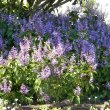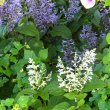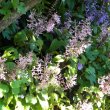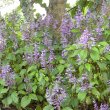| Botanical Name |
|
| Family |
Lamiaceae - The mint and salvia family |
| Pronunciation |
plek-TRAN-thus ek-LON-ee-eye |
| Common Name(s) |
English: Plectranthus; Spur flower
Afrikaans: Grootspoorsalie
|
| Plant Group |
- Shrub A woody plant of relatively low height, having several stems arising from the base and lacking a single trunk; a bush.
|
| Plant Size |
- Medium
| Tree | 10m to 16m |
| Shrub | 1m to 2m |
| Perennial/ground cover | 40cm to 60cm |
| Bulb | 40cm to 60cm |
| Succulent | 40cm to 60cm |
|
| Position |
- Canopy Shade Canopy shade is found below closely grown trees where some light filters through. Ideal for the protection of herbaceous plants.
- Dry Shade Shady areas where soil has poor water retention or are dependent on rain for their moisture needs.
- Light or Dappled Shade Found below trees with sparse, open foliage. Ideal for the protection of herbaceous plants.
- Partial Shade The area is in shade for part of the day and in full sun for part of the day.
|
| General Information |
- Drought Tolerance: Moderate The plant is moderately adapted to arid conditions and can survive short periods of drought and high temperatures without extra water.
- Evergreen Plants that have leaves all year round.
- Frost: Half-hardy The plant is able to survive low temperatures and some frost but requires protection against severe frost.
- Prune hard after flowering Fast growing shrubs that grow lanky within a season. Cut off branches and stems of these plants to a third of their original length. This will increase the yield of flowers, improve the plants shape and enhance the structural strength of main branches.
- Water Moderate These plants will need some extra watering compared to water-wise plants. Plant them together, in at least some shade and in a convenient proximity to the house so that grey water can be utilised during times of drought.
|
| Specific Information |
This is a tall, shrubby plectranthus. Medley-Wood' is particularly robust and grows successfully in dry shade. Three well-known varieties of Plectranthus ecklonii are: Medley-Wood' - blue; 'Tommy' - white; 'Erma' - pink Plectranthus ecklonii is reportedly more able to tolerate a bit more sun than many others of this species.
|
| Ad Break |
|
| Flowers |
| Description |
|
| Season |
- Autumn Plants will seldom bloom for the entire season as given in the list, but should flower during a period within these parameters.
|
| Colour |
|
| Growth Rate |
- Very Fast Specifying growth rate can be very misleading as there is considerable variation of growth rate depending on type and species of plant, available water, supplementary feeding, mulching and general care, as well as the plants suitability and adaptability to the garden environment.
|
| Plant Uses |
- Accent or Focal Point A plant used to attract the attention because of its colour or form.
- Attracts bees, butterflies or other insects This plant attracts insects which can be food for birds or other creatures in your garden.
- Border A strip of ground, at the edge of a driveway or path in which ornamental plants or shrubs are planted.
- Container Trees, shrubs and ornamental species that can adapt to growing in a restricted environment.
- Filler Either a fast growing tree or shrub used temporarily to fill in an area while the permanent plants grow to a desired size, or a plant used to fill gaps in borders or beds.
- Hedge Suitable trees or shrubs planted relatively close together so that the branches intertwine to create a barrier. This can be formal – the plants are regularly trimmed to produce a neat shape, or informal – the plants are left to themselves to create a natural hedgerow.
- Pioneer for new gardens A very fast growing plant, able to withstand hardship, that can be used to populate land that has recently been cleared of natural vegetation. These plants pave the way for slower-growing species by adding nutrients to the soil and creating leaf litter.
- Stabilize Banks Plant is used to prevent soil erosion because their roots will form a mat that stabilizes the soil and keeps it from washing away in heavy rains.
- Suitable for coastal gardens Plants adapted to dry, sandy soil, forceful wind, limited rainfall and intense sunlight.
- Wild Garden An indigenous garden planted for the benefit of wildlife and birds. Provides food, water, a variety of mini-biomes and no poisonous chemicals are used.
|
| Distribution and Habitat |
Eastern Cape Province, KwaZulu-Natal, Mpumalanga
|
| Planting Suggestions |
Plectranthus will grow and flower with the most meager feeding, but for quick, lush growth and a profusion of flowers, it is worthwhile giving the plants a strong start. Plant plectranthus in well-drained loam or sandy soil with the addition of compost and fertiliser according to your soil needs. Mulch thickly to retain water. Regular watering is also needed but don't over-water - it is best to keep the plants as water wise as possible. Frequent light pruning or tipping is necessary to keep plectranthus compact and bushy. Prune back hard after flowering during midwinter.
|
| Medicinal Uses |
|
| Ad Break |
|









Comments
seeds
Do you have any seeds available of white or pink plectranthus ecklonii?
Plectranthus ecklonii seeds
Hi Hazel
As these plants are presently in flower, I have no seed available. I must add that my pink and white plants have never seeded themselves, while the blues seed quite prolifically. It is quite possible that this is because the pink and white are (to the best of my knowledge) hybrids and therefore if they do seed, they may not be viable or may not come out the same colour.
The best way to obtain the plants would be to get slips or cuttings which grow very easily. If you can't get them anywhere, contact me at kumbulanursery@gmail.com and I can post cuttings.
Hopes this helps
Regards
Lorraine
plectranthus ecklonii
Would like to be notified when pink and white seeds are available.
Seeds
Will do so if they actually set seed.
Plectranthus ecklonii
Please let me know if I can buy this plant or cuttings from you or anybody out there.
I am looking for the White, Pink, Lavender, Red (Plectranthus ecklonii Cape Angels Red)
See white here https://www.flickr.com/photos/jayjayc/3734743690/
Hoping to hear from you soon.
Kind regards
Anne-Mari
Plectranthus Hybrid: Cape Angel
Hi Anne-Marie
The Cape Angel plectranthus are a hybrid of Plectranthus saccatus and Plectranthus hilliardiae and produce a much smaller, bushy plant compared to Plectranthus ecklonii.
I have seen the Cape Angel hybrids on sale at many nurseries. Let me know where are you situated and I will see if I can make further suggestions.
Kind regards
Lorraine
Discuss this plant
Share knowledge, ask a question or give an experience.